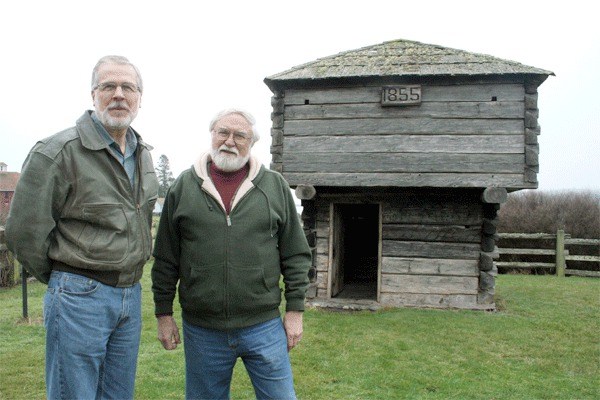A Central Whidbey blockhouse that has fallen into disrepair may get some spare parts from a historic casket factory in Everett.
The Crockett Blockhouse was once part of a makeshift fort, with a matching blockhouse and palisade with spiked tops, constructed in 1855 to protect Colonel Walter Crockett’s cabin from Indian raids. Today, it is one of four blockhouses still standing in the Coupeville area, but the last to be restored.
Harrison Goodall, an architecture conservator who lives in Langley, wrote a plan to restore the historic structure which may soon be enacted. He explained that the ownership of the blockhouse was fuzzy until a county official did some research and discovered that the county owns it, along with the tiny piece of property it sits on.
Public Works Director Bill Oakes, who’s also the parks director, said that nine of the rough-hewn logs on the blockhouse are rotten and need to be replaced. The problem is that the county doesn’t have the money to do the work.
Once again, Ron Boyer and the Coupeville Lions are coming to the rescue. If all goes well, the Crockett Blockhouse will be the third blockhouse that the group has helped restore. Boyer organized Coupeville Lions members and other volunteers to replace the roof on the Alexander Blockhouse next to the Island County Historical Museum in 2008. The year before that, the Lions helped Roger Sherman and the Sunnyside Cemetery District restore the Davis Blockhouse, which is located in the cemetery. The cemetery district also hired professionals to do restoration work.
Boyer got an estimate of $15,000 to have replacement logs custom milled for the Crockett Blockhouse. Getting the money from cash-strapped county officials may have been tough, but then an opportunity came to light.
To the horror of many history-minded folks, the Port of Everett is “deconstructing” the historic Collins building, a former casket factory. Port officials, however, were required to offer the salvaged materials for free to groups or individuals planning to preserve historic structures. The men say they hoping to get some logs from the casket factory that can be used for the blockhouse.
Goodall said he will work with Boyer and other volunteers to shape and place the logs. Since the original logs were fashioned with a broad ax, he said they’ll use a foot adze to give the replacement logs a hand-tooled look.
In addition, Gooddall said the shake roof will have to be replaced some day.
Mark Preiss, manager of Ebey’s Landing National Historical Reserve, said the Crockett Blockhouse will be the last of the four blockhouses on the reserve to get a facelift. In addition to the Alexander and Davis blockhouses, the Jacob Ebey Blockhouse, located next to the Jacob Ebey house, was restored by the National Park Service a few years ago.
Lance Loomis, a Crockett Farm resident and local historian, has researched the interesting history of the Crockett blockhouses. He explained that the small group of white pioneers living on Central Whidbey in 1855 became alarmed by reports of hostile Native Americans and held a community meeting. They decided to build blockhouses to protect themselves in case of attack. The first was built for John Crockett, he said, then two blockhouses and a spiky palisade were build around Walter Crockett’s home next to Crockett Lake.
“It looked like a fort,” he said.
According to Loomis, there’s no record of Indians ever attacking a blockhouse on Whidbey. Colonel Isaac Ebey’s wife and children reportedly ran to their blockhouse for shelter after a group of Native Americans shot and beheaded Ebey in 1857, but the Indians left without further violence.
The blockhouses, Loomis said, were meant to temporarily protect a family behind thick walls. With the Crockett blockhouses, the plan was that women and children would lock themselves in the upper area while armed men stood guard below. The remaining Crockett Blockhouse has holes to stick rifles through on both levels.
Loomis said the panic over Indian attacks disappeared after treaties were signed circa 1858, but the blockhouses remained as symbols of earlier times.
Years later, one of the Crockett blockhouses was sold to Ezra Meeker, an early pioneer who traveled the Oregon trail and later worked to memorialize the trail. He used the blockhouse for the entrance to his restaurant at the Alaska-Yukon-Pacific Exposition, the world fair held in Seattle in 1909. There are reports that the blockhouse was then moved to Point Defiance Park in Tacoma, but Loomis has been unable to find any trace of it.
The other blockhouse remained at the Crockett Farm, but was later moved to its present site.



